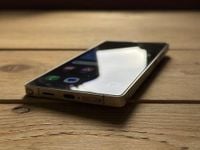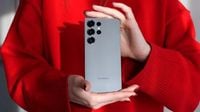The smartphone market has been abuzz with the release of the Samsung Galaxy S25 Ultra, a flagship device that promises cutting-edge technology and a premium user experience. Purchased at the start of sales from MTS with a 0-0-24 installment plan, the device set the author back 142,000 rubles, or approximately 130,000 rubles after factoring in the cost of the included Buds 3 Pro headphones. However, this hefty price tag comes with caveats, as the phone does not include a power adapter, case, or screen protector, which can lead to additional expenses for new owners.
One of the major disappointments is the included charging cable, which does not support the proprietary 45-watt charging but is limited to 25 watts. This means buyers will need to purchase a compatible cable separately to take full advantage of fast charging capabilities. The Galaxy S25 Ultra is available in four colors, with the author particularly impressed by the Black Titanium version, noting its dark matte finish and iridescent metal accents as visually appealing.
In terms of design, the S25 Ultra has made significant strides in ergonomics compared to its predecessor, the S24 Ultra. The new model is 14 grams lighter, thinner, and narrower, with a more streamlined appearance due to the removal of excess metal from the frame. This design change not only enhances the phone's aesthetic appeal but also improves its comfort during use. The ultrasonic fingerprint scanner has proven reliable in the 10 days since purchase, with no instances of failure reported, even in cold weather.
The SIM slot, located at the bottom of the device, accommodates two nano SIM cards and can also function with eSIMs, providing flexibility for users. The S Pen stylus remains a feature of the S25 Ultra but has seen a downgrade, lacking Bluetooth and a battery, which eliminates some previously available features like air gestures for presentations. Samsung attempted to justify this change by claiming that only about 1% of users utilized the Bluetooth functions, a statistic that raises questions about how many users actually rely on the stylus for its intended features.
Samsung's presentation of the S25 Ultra emphasized artificial intelligence, but the author felt that more attention should have been given to the device's physical design and usability. The dynamic refresh rate of the screen ranges from 30 Hz on the Always-On Display (AOD) to 120 Hz during active use, ensuring smooth performance across various applications. The interface operates at 120 Hz while gaming can reach up to 240 Hz, a feature that has garnered praise from the author for its seamless integration without the need for manual adjustments.
Camera capabilities have also seen improvements. The S25 Ultra’s main camera system is equipped with enhanced algorithms that adapt to lighting conditions, ensuring superior photo quality. The new camera interface includes ten analog film filters, allowing users to adjust parameters like contrast and graininess for a more personalized touch. Video recording has been refined, with smooth transitions between camera modules during filming, bolstered by AI enhancements that improve the overall quality of the footage.
However, while the camera performs admirably, the author notes that it may not be on par with some of the top Chinese competitors in the market, which often deliver more striking images. The Snapdragon 8 Elite for Galaxy chipset powers the device, offering a performance bump over the previous generation but showing similar CPU performance. In benchmarks, the S25 Ultra demonstrates a 37.5% increase in 3D graphics performance compared to the S24 Ultra, although thermal throttling remains an issue, with peak temperatures reaching 44 degrees Celsius.
One notable improvement is in the battery life. The S25 Ultra houses a 5000 mAh battery that delivers between 6 to 8 hours of active screen time under mixed usage conditions, outperforming the S24 Ultra and coming close to the iPhone 16 Pro Max. The charging process is straightforward: a blue animation indicates very fast charging, with full battery replenishment taking around one hour, while a green animation signals a slower charge.
The author expresses satisfaction with the overall performance of the device, noting that OneUI 7.0 has been optimized for smoother animations and responsiveness. Notifications and background operations function without issues, contributing to a seamless user experience. However, there are some frustrating software quirks, such as problems with Android Auto and the AI keyboard assistant that interfere with messaging apps.
In summary, the Samsung Galaxy S25 Ultra is positioned as a premium device that competes closely with other flagship smartphones, particularly in terms of design, camera quality, and user experience. While it may not completely eclipse its competitors, it offers a solid option for those seeking an Android device that balances functionality with style. The author recommends the S25 Ultra for users who prefer Android over iPhone and appreciate a device that is intuitive and easy to use.
For those considering a purchase, it is advised to shop around for better deals, as the retail price may not reflect the best value for money.





